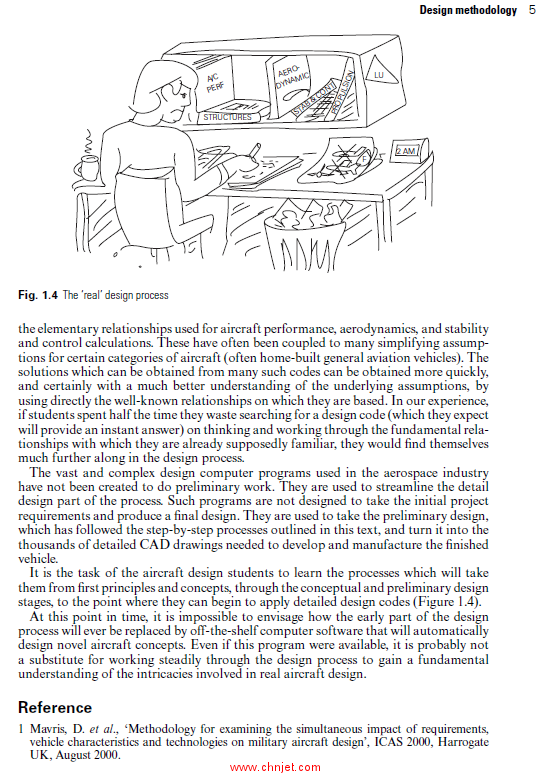马上注册,结交更多好友,享用更多功能,让你轻松玩转社区。
您需要 登录 才可以下载或查看,没有账号?立即注册

×
《Aircraft Design Projects: For Engineering Students》
飞机设计项目:工科学生
作者:
Lloyd R. Jenkinson
James F. Marchman III
出版社:BH
出版时间:2003年
《Aircraft Design Projects: For Engineering Students》

《Aircraft Design Projects: For Engineering Students》

《Aircraft Design Projects: For Engineering Students》

《Aircraft Design Projects: For Engineering Students》

目录
Preface
xiii
xvi
xvii
Acknowledgements
Introduction
1 Design methodology
1
2 Preliminary design
6
2.1 Problem definition
6
7
8
2.1.1
2.1.2
2.1.3
Understanding the problem 8
2.1.4
Innovation 9
2.1.5
Organising the design process 10
2.1.6
Summary 11
The customers
Aircraft viability
2.2 Information retrieval 11
2.2.1 Existing and competitive aircraft 11
2.2.2 Technical reports 12
2.2.3 Operational experience 12
2.3 Aircraft requirements 12
2.3.1 Market and mission issues 13
2.3.2 Airworthiness and other standards 13
2.3.3 Environmental and social issues 13
2.3.4 Commercial and manufacturing considerations 14
2.3.5 Systems and equipment requirements 14
2.4 Configuration options 14
2.5 Initial baseline sizing 15
2.5.1 Initial mass (weight) estimation 16
2.5.2 Initial layout drawing 19
2.6 Baseline evaluation 19
2.6.1
Mass statement 19
2.6.2
Aircraft balance 21
2.6.3
Aerodynamic analysis 22
2.6.4
Engine data 24
2.6.5
Aircraft performance 25
2.6.6
Initial technical report 25
2.7 Refining the initial layout 25
2.7.1 Constraint analysis 26
2.7.2 Trade-off studies 29
vi Contents
2.8 Refined baseline design 31
2.9 Parametric and trade studies 32
2.9.1 Example aircraft used to illustrate trade-off and
parametric studies 33
2.10 Final baseline configuration 39
2.10.1 Additional technical considerations 39
2.10.2 Broader-based considerations 39
2.11 Type specification 40
2.11.1 Report format 40
2.11.2 Illustrations, drawings and diagrams 41
References 41
3 Introduction to the project studies 43
4 Project study: scheduled long-range business jet 46
4.1 Introduction 47
4.2 Project brief 49
4.2.1 Project requirements 50
4.3 Project analysis 50
4.3.1 Payload/range 50
4.3.2 Passenger comfort 51
4.3.3 Field requirements 51
4.3.4 Technology assessments 52
4.3.5 Marketing 53
4.3.6 Alternative roles 54
4.3.7 Aircraft developments 54
4.3.8 Commercial analysis 55
4.4 Information retrieval 56
4.5 Design concepts 57
4.5.1 Conventional layout(s) 57
4.5.2 Braced wing/canard layout 58
4.5.3 Three-surface layout 59
4.5.4 Blended body layout 60
4.5.5 Configuration selection 61
4.6 Initial sizing and layout 62
4.6.1 Mass estimation 62
4.6.2 Engine size and selection 63
4.6.3 Wing geometry 63
4.6.4 Fuselage geometry 67
4.6.5 Initial ‘baseline aircraft’ general arrangement drawing 68
4.7 Initial estimates 70
4.7.1 Mass and balance analysis 70
4.7.2 Aerodynamic estimations 75
4.7.3 Initial performance estimates 76
4.7.4 Constraint analysis 78
4.7.5 Revised performance estimates 79
4.7.6 Cost estimations 80
4.8 Trade-off studies 82
4.8.1 Alternative roles and layout 82
4.8.2 Payload/range studies 85
Contents vii
4.8.3 Field performance studies 86
4.8.4 Wing geometry studies 87
4.8.5 Economic analysis 91
4.9 Initial ‘type specification’ 96
4.9.1 General aircraft description 96
4.9.2 Aircraft geometry 97
4.9.3 Mass (weight) and performance statements 97
4.9.4 Economic and operational issues 98
4.10 Study review 99
References 100
5 Project study: military training system 101
5.1 Introduction 102
5.2 Project brief 102
5.2.1 Aircraft requirements 103
5.2.2 Mission profiles 104
5.3 Problem definition 105
5.4 Information retrieval 106
5.4.1 Technical analysis 108
5.4.2 Aircraft configurations 110
5.4.3 Engine data 110
5.5 Design concepts 110
5.6 Initial sizing 112
5.6.1 Initial baseline layout 113
5.7 Initial estimates 115
5.7.1 Mass estimates 115
5.7.2 Aerodynamic estimates 117
5.7.3 Performance estimates 119
5.8 Constraint analysis 129
5.8.1 Take-off distance 129
5.8.2 Approach speed 129
5.8.3 Landing distance 130
5.8.4 Fundamental flight analysis 130
5.8.5 Combat turns at SL 130
5.8.6 Combat turn at 25 000 ft 131
5.8.7 Climb rate 131
5.8.8 Constraint diagram 131
5.9 Revised baseline layout 132
5.9.1 Wing fuel volume 133
5.10 Further work 134
5.11 Study review 137
5.11.1 Strengths 137
5.11.2 Weaknesses 137
5.11.3 Opportunities 139
5.11.4 Threats 139
5.11.5 Revised aircraft layout 140
5.12 Postscript 141
References 141
viii Contents
6 Project study: electric-powered racing aircraft 143
6.1 Introduction 144
6.2 Project brief 144
6.2.1 The racecourse and procedures 144
6.2.2 History of Formula 1 racing 145
6.2.3 Comments from a racing pilot 146
6.2.4 Official Formula 1 rules 147
6.3 Problem definition 149
6.4 Information retrieval 150
6.4.1 Existing aircraft 150
6.4.2 Configurational analysis 152
6.4.3 Electrical propulsion system 154
6.5 Design concepts 157
6.6 Initial sizing 158
6.6.1 Initial mass estimations 159
6.6.2 Initial aerodynamic considerations 162
6.6.3 Propeller analysis 165
6.7 Initial performance estimation 166
6.7.1 Maximum level speed 166
6.7.2 Climb performance 169
6.7.3 Turn performance 171
6.7.4 Field performance 173
6.8 Study review 173
References 174
7 Project study: a dual-mode (road/air) vehicle 175
7.1 Introduction 176
7.2 Project brief (flying car or roadable aircraft?) 176
7.3 Initial design considerations 177
7.4 Design concepts and options 179
7.5 Initial layout 181
7.6 Initial estimates 186
7.6.1 Aerodynamic estimates 186
7.6.2 Powerplant selection 189
7.6.3 Weight and balance predictions 190
7.6.4 Flight performance estimates 190
7.6.5 Structural details 193
7.6.6 Stability, control and ‘roadability’ assessment 196
7.6.7 Systems 197
7.6.8 Vehicle cost assessment 198
7.7 Wind tunnel testing 199
7.8 Study review 200
References 201
8 Project study: advanced deep interdiction aircraft 202
8.1 Introduction 203
8.2 Project brief 203
8.2.1 Threat analysis 203
8.2.2 Stealth considerations 204
8.2.3 Aerodynamic efficiency 206
Contents ix
8.3 Problem definition 208
8.4 Design concepts and selection 210
8.5 Initial sizing and layout 213
8.6 Initial estimates 215
8.6.1 Initial mass estimations 216
8.6.2 Initial aerodynamic estimations 217
8.7 Constraint analysis 221
8.7.1 Conclusion 227
8.8 Revised baseline layout 228
8.8.1 General arrangement 228
8.8.2 Mass evaluation 233
8.8.3 Aircraft balance 233
8.8.4 Aerodynamic analysis 234
8.8.5 Propulsion 241
8.9 Performance estimations 242
8.9.1 Manoeuvre performance 242
8.9.2 Mission analysis 250
8.9.3 Field performance 254
8.10 Cost estimations 259
8.11 Trade-off studies 261
8.12 Design review 263
8.12.1 Final baseline aircraft description 263
8.12.2 Future considerations 267
8.13 Study review 268
References 268
9 Project study: high-altitude, long-endurance (HALE) uninhabited aerial
surveillance vehicle (UASV) 270
9.1 Introduction 271
9.2 Project brief 271
9.2.1 Aircraft requirements 272
9.3 Problem definition 272
9.4 Initial design considerations 275
9.5 Information retrieval 275
9.5.1 Lockheed Martin U-2S 276
9.5.2 Grob Strato 2C 276
9.5.3 Northrop Grumman RQ-4A Global Hawk 277
9.5.4 Grob G520 Strato 1 277
9.5.5 Stemme S10VC 277
9.6 Design concepts 278
9.6.1 Conventional layout 279
9.6.2 Joined wing layout 280
9.6.3 Flying wing layout 280
9.6.4 Braced wing layout 281
9.6.5 Configuration selection 282
9.7 Initial sizing and layout 283
9.7.1 Aircraft mass estimation 283
9.7.2 Fuel volume assessment 285
9.7.3 Wing loading analysis 285
9.7.4 Aircraft speed considerations 286
x Contents
9.7.5 Wing planform geometry 288
9.7.6 Engine sizing 290
9.7.7 Initial aircraft layout 292
9.7.8 Aircraft data summary 293
9.8 Initial estimates 294
9.8.1
Component mass estimations 294
9.8.2
Aircraft mass statement and balance 297
9.8.3
Aircraft drag estimations 298
9.8.4
Aircraft lift estimations 299
9.8.5
Aircraft propulsion 300
9.8.6
Aircraft performance estimations 300
9.9 Trade-off studies 305
9.10 Revised baseline layout 305
9.11 Aircraft specification 307
9.11.1 Aircraft description 307
9.11.2 Aircraft data 307
9.12 Study review 308
References 309
10 Project study: a general aviation amphibian aircraft 310
10.1 Introduction 311
10.2 Project brief 311
10.2.1 Aircraft requirements 312
10.3 Initial design considerations 312
10.4 Design concepts 312
10.5 Initial layout and sizing 313
10.5.1 Wing selection 313
10.5.2 Engine selection 314
10.5.3 Hull design 314
10.5.4 Sponson design 316
10.5.5 Other water operation considerations 317
10.5.6 Other design factors 318
10.6 Initial estimates 318
10.6.1 Aerodynamic estimates 318
10.6.2 Mass and balance 318
10.6.3 Performance estimations 321
10.6.4 Stability and control 323
10.6.5 Structural details 323
10.7 Baseline layout 324
10.8 Revised baseline layout 325
10.9 Further work 325
10.10 Study review 328
References 329
11 Design organisation and presentation 331
11.1 Student’s checklist 332
11.1.1 Initial questions 332
11.1.2 Technical tasks 332
11.2 Teamworking 333
11.2.1 Team development 335
Contents xi
11.2.2 Team member responsibilities 336
11.2.3 Team leadership requirements 336
11.2.4 Team operating principles 337
11.2.5 Brainstorming 337
11.3 Managing design meetings 338
11.3.1 Prior to the meeting 339
11.3.2 Minutes of the meeting 339
11.3.3 Dispersed meetings 341
11.4 Writing technical reports 341
11.4.1 Planning the report 342
11.4.2 Organising the report 342
11.4.3 Writing the report 343
11.4.4 Referencing 344
11.4.5 Use of figures, tables and appendices 345
11.4.6 Group reports 346
11.4.7 Review of the report 347
11.5 Making a technical presentation 348
11.5.1 Planning the presentation 349
11.5.2 Organising the presentation 349
11.5.3 Use of equipment 350
11.5.4 Management of the presentation 351
11.5.5 Review of the presentation 352
11.6 Design course structure and student assessment 353
11.6.1 Course aims 353
11.6.2 Course objectives 354
11.6.3 Course structure 354
11.6.4 Assessment criteria 355
11.6.5 Peer review 356
11.7 Naming your aircraft 356
Footnote 357
Appendix A: Units and conversion factors 359
Derived units 360
Funny units 360
Conversions (exact conversions can be found in British Standards
BS350/2856) 361
Some useful constants (standard values) 362
Appendix B: Design data sources 363
Technical books (in alphabetical order) 363
Reference books 365
Research papers 365
Journals and articles 366
The Internet 366
Index 367
这本书出中文版了
飞机设计案列教程
《Aircraft Design Projects: For Engineering Students》

专业书籍
下载地址:(回复后可见)
| ![]()